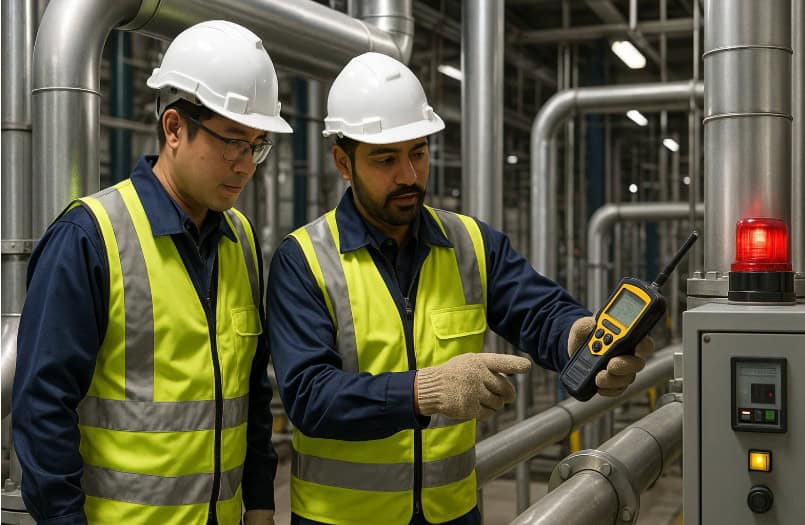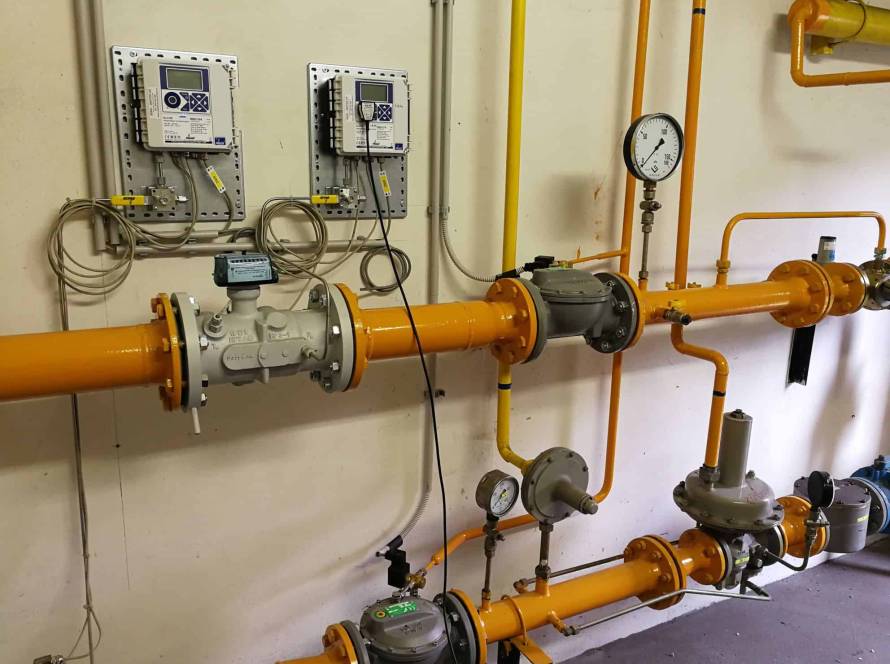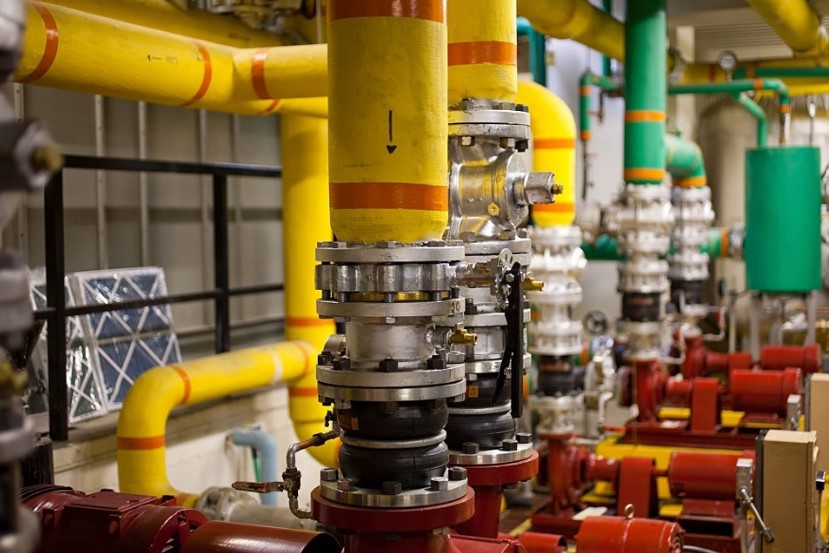5 Common Causes of Gas Leaks in Malaysia (and How to Detect Them Early)

The risk of gas leaks is a serious concern across Malaysian industries — from food processing and manufacturing plants to commercial kitchens and refineries. Even a minor leak can lead to safety hazards, production downtime, and costly losses.
Most gas leaks, however, are preventable. By understanding their causes and detecting them early, businesses can maintain safe operations, comply with Department of Occupational Safety and Health (DOSH) guidelines, and protect both employees and assets.
In this article, we’ll explore the five most common causes of gas leaks in Malaysia and how your facility can detect them before they become dangerous.
Why Gas Leaks Are a Growing Concern in Malaysian Industries
Malaysia’s industrial growth has led to increasing use of liquefied petroleum gas (LPG), methane, carbon dioxide, and other combustible gases. These are essential for powering machinery, heating processes, and laboratory operations.
However, when not properly managed, leaks from gas pipelines or storage systems can cause fire hazards, equipment damage, and even explosions. DOSH Malaysia emphasises that gas-handling equipment should be routinely inspected and that leak detection systems are a key component of workplace safety.
If left unchecked, a gas leak can also disrupt production lines and lead to costly downtime — making early detection not just a safety measure, but also a business-critical investment.
Learn more: The Importance of Gas Detectors and Their Safety Benefits
1. Faulty or Aging Gas Pipelines
Over time, metal pipelines and fittings can corrode or develop cracks due to high pressure, vibration, or exposure to moisture. Older industrial facilities in Malaysia, especially those with LPG or natural gas systems, are more susceptible.
Signs of trouble:
- Corrosion or rust around pipe joints
- Unusual smell or hissing sounds
- Higher gas consumption despite stable production
Early detection method:
Install fixed gas leak detectors near joints, valves, and along main gas lines. These sensors continuously monitor gas concentration and can automatically trigger alarms before leaks escalate.
2. Improper Installation or Poor Maintenance
Incorrect installation or using low-quality fittings often leads to small but persistent leaks. Inconsistent maintenance routines also worsen the problem. This is common in commercial kitchens, LPG storage areas, or industrial plants where technicians handle frequent gas line changes.
Prevention tips
- Always use certified installers and high-quality hoses or valves.
- Conduct regular pressure tests on your system.
- Use portable gas leak detectors to perform spot inspections during maintenance.
Learn how to identify and fix related issues: Common Gas Regulator Problems and How to Fix Them
3. Leaking Valves and Seals in Equipment
Valves, seals, and gaskets in compressors, tanks, and burners wear out over time, especially under high-pressure operations. These small leaks often go unnoticed until gas accumulation triggers alarms or odour detection.
Detection solution
Use ultrasonic or infrared gas detectors, which can sense leaks without physical contact. These are especially effective in noisy industrial environments or where gas is colourless and odourless.
Explore: Gas Detector vs. Gas Monitor — What’s the Difference?
4. Damaged Flexible Hoses and Connectors
Flexible hoses used to connect gas tanks or equipment can deteriorate due to heat, vibration, or bending stress. Cracks, punctures, or loose fittings can quickly lead to leaks, especially in high-temperature environments.
Detection and prevention
- Replace hoses at the manufacturer’s recommended intervals.
- Conduct regular leak tests using portable handheld detectors.
- Use industrial-grade stainless steel flexible hoses for better durability.
For portable inspection use, the GD-Comet Gas Detector offers fast and accurate readings suitable for both maintenance and safety audits.
5. Human Error and Neglected Safety Checks
Human factors — such as forgetting to close valves properly, skipping routine maintenance, or neglecting detector calibration — account for many gas-related incidents.
Best practices to avoid errors
- Establish a strict maintenance schedule and safety checklist.
- Train employees on how to respond to gas alarm signals.
- Calibrate all gas detectors every 6–12 months to ensure accurate readings.
Reference: Gas Detector Malaysia – FAQ, Uses, Calibration & Safety
How to Detect Gas Leaks Early
Modern detection systems use a mix of fixed, portable, and smart networked gas detectors to provide real-time alerts.
Key Detection Methods
- Fixed Detectors – Installed at key points to provide continuous monitoring.
- Portable Detectors – Handheld devices for maintenance teams to perform checks in confined or high-risk areas.
- Smart Systems – Cloud-connected sensors that log readings and send automatic alerts to safety managers.
Each system uses specific technologies, such as infrared, catalytic bead, or semiconductor sensors, depending on the gas type and environment.
🔗 Deep dive: Gas Leak Detector Guide
🔗 Compare systems: Choose the Best Gas Detection System for Your Business
Pro Tip:
Always verify your gas detectors’ specifications before installation. The S-LOK Liquid & Gas Detector (PDF) is an example of a high-sensitivity sensor suitable for industrial environments.
The Business Impact of Early Detection
Early gas detection protects not just lives but also business continuity. By preventing leaks:
- You reduce equipment downtime and repair costs.
- You maintain compliance with Malaysian safety standards.
- You avoid potential legal and insurance complications.
🔗 Read more: Gas Leak Detector Malaysia – Product & Solutions
A proactive gas safety system can also improve workplace morale, ensure regulatory compliance, and strengthen your company’s reputation as a safety-first operation.
FAQ About Gas Leak Detection
What gases can industrial gas leak detectors detect?
Most industrial gas leak detectors can sense combustible and toxic gases such as LPG, methane, propane, butane, hydrogen, and carbon monoxide. Some advanced detectors also monitor oxygen levels in confined spaces. Always choose a detector based on your gas type and environment.
How often should gas leak detectors be calibrated in Malaysia?
For compliance and accuracy, gas detectors should be calibrated every 6 to 12 months, as recommended by most manufacturers and safety standards. Regular calibration ensures the sensors respond correctly to gas concentration levels.
What is the difference between portable and fixed gas detectors?
Fixed detectors provide continuous monitoring in high-risk zones, while portable detectors are used by maintenance teams for periodic checks or inspections. Many facilities use both for comprehensive coverage.
Where should gas leak detectors be installed in an industrial facility?
Placement depends on the type of gas used. For example, lighter gases like hydrogen or methane accumulate near the ceiling, while heavier gases such as LPG stay near the floor. Detectors should be positioned near joints, valves, and ventilation points for maximum coverage.
What Malaysian safety regulations apply to gas leak detection systems?
The Department of Occupational Safety and Health (DOSH) requires compliance with safety standards under the Factories and Machinery Act 1967 and Occupational Safety and Health Act 1994. Facilities using combustible gases must maintain safe equipment, conduct periodic inspections, and install reliable detection systems.
Conclusion
Gas leaks are often caused by preventable issues like equipment wear, improper installation, and missed maintenance. Detecting them early is key to avoiding accidents, property damage, and downtime.
Investing in a reliable gas leak detection system is not only a regulatory requirement — it’s smart business.
🔗 Explore our full range of solutions: GD-Comet Gas Detector
Disclaimer
This article is intended for general informational purposes only. Always consult a qualified professional or certified gas technician before performing installation, repair, or calibration of gas detection systems. Improper handling of gas lines or detectors can result in serious injury or damage.



